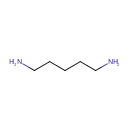| References: |
- Becker K, Csikos M, Sardy M, Szalai ZS, Horvath A, Karpati S: Identification of two novel nonsense mutations in the transglutaminase 1 gene in a Hungarian patient with congenital ichthyosiform erythroderma. Exp Dermatol. 2003 Jun;12(3):324-9. Pubmed: 12823447
- Chen KC, Amsel R, Eschenbach DA, Holmes KK: Biochemical diagnosis of vaginitis: determination of diamines in vaginal fluid. J Infect Dis. 1982 Mar;145(3):337-45. Pubmed: 7061879
- Cooke M, Leeves N, White C: Time profile of putrescine, cadaverine, indole and skatole in human saliva. Arch Oral Biol. 2003 Apr;48(4):323-7. Pubmed: 12663078
- Fujita K, Nagatsu T, Shinpo K, Maruta K, Teradaira R, Nakamura M: Improved analysis for urinary polyamines by use of high-voltage electrophoresis on paper. Clin Chem. 1980 Oct;26(11):1577-82. Pubmed: 7418205
- Gabastou JM, Nugon-Baudon L, Robert Y, Manuel C, Vaissade P, Bourgeon E, Sibeud M, Szylit O, Bourlioux P: [Digestive amines of bacterial origin and behavior disorders. Apropos of a case] Pathol Biol (Paris). 1996 Apr;44(4):275-81. Pubmed: 8763591
- Goldberg S, Kozlovsky A, Gordon D, Gelernter I, Sintov A, Rosenberg M: Cadaverine as a putative component of oral malodor. J Dent Res. 1994 Jun;73(6):1168-72. Pubmed: 8046106
- Hallak A, Rosenberg R, Gilat T, Somjen GJ: Determination of free polyamines in human bile by high-performance liquid chromatography. Clin Sci (Lond). 1993 Oct;85(4):451-4. Pubmed: 8222511
- Hamana, K. (1996). "Distribution of diaminopropane and acetylspermidine in Enterobacteriaceae." Can J Microbiol 42:107-114. Pubmed: 8742354
- Kai M, Ogata T, Haraguchi K, Ohkura Y: High-performance liquid chromatographic determination of free and total polyamines in human serum as fluorescamine derivatives. J Chromatogr. 1979 Jun 11;163(2):151-60. Pubmed: 541366
- Kanehisa, M., Goto, S., Sato, Y., Furumichi, M., Tanabe, M. (2012). "KEGG for integration and interpretation of large-scale molecular data sets." Nucleic Acids Res 40:D109-D114. Pubmed: 22080510
- Keseler, I. M., Collado-Vides, J., Santos-Zavaleta, A., Peralta-Gil, M., Gama-Castro, S., Muniz-Rascado, L., Bonavides-Martinez, C., Paley, S., Krummenacker, M., Altman, T., Kaipa, P., Spaulding, A., Pacheco, J., Latendresse, M., Fulcher, C., Sarker, M., Shearer, A. G., Mackie, A., Paulsen, I., Gunsalus, R. P., Karp, P. D. (2011). "EcoCyc: a comprehensive database of Escherichia coli biology." Nucleic Acids Res 39:D583-D590. Pubmed: 21097882
- Kohler H, Rodrigues SP, Maurelli AT, McCormick BA: Inhibition of Salmonella typhimurium enteropathogenicity by piperidine, a metabolite of the polyamine cadaverine. J Infect Dis. 2002 Oct 15;186(8):1122-30. Epub 2002 Sep 20. Pubmed: 12355363
- Konikoff F, Goldman G, Halpern Z, Somjen GJ, Gilat T: Polyamines--potential nucleating factors in bile. Liver. 1990 Jun;10(3):173-6. Pubmed: 2385158
- Kubilus J, Baden HP: Isolation of two immunologically related transglutaminase substrates from cultured human keratinocytes. In Vitro. 1982 May;18(5):447-55. Pubmed: 6180968
- Kubota S, Okada M, Imahori K, Ohsawa N: A new simple enzymatic assay method for urinary polyamines in humans. Cancer Res. 1983 May;43(5):2363-7. Pubmed: 6831460
- Muskiet FA, van den Berg GA, Kingma AW, Fremouw-Ottevangers DC, Halie MR: Total polyamines and their non-alpha-amino acid metabolites simultaneously determined in urine by capillary gas chromatography, with nitrogen-phosphorus detector; and some clinical applications. Clin Chem. 1984 May;30(5):687-95. Pubmed: 6713628
- Sreekumar A, Poisson LM, Rajendiran TM, Khan AP, Cao Q, Yu J, Laxman B, Mehra R, Lonigro RJ, Li Y, Nyati MK, Ahsan A, Kalyana-Sundaram S, Han B, Cao X, Byun J, Omenn GS, Ghosh D, Pennathur S, Alexander DC, Berger A, Shuster JR, Wei JT, Varambally S, Beecher C, Chinnaiyan AM: Metabolomic profiles delineate potential role for sarcosine in prostate cancer progression. Nature. 2009 Feb 12;457(7231):910-4. Pubmed: 19212411
- van den Berg GA, Schaaf JM, Nagel GT, Teelken AW, Muskiet FA: Determination of polyamines and metabolites in cerebrospinal fluid by isotope dilution mass fragmentography, and a clinical application. Clin Chim Acta. 1987 Jun 15;165(2-3):147-54. Pubmed: 3308180
- van der Werf, M. J., Overkamp, K. M., Muilwijk, B., Coulier, L., Hankemeier, T. (2007). "Microbial metabolomics: toward a platform with full metabolome coverage." Anal Biochem 370:17-25. Pubmed: 17765195
- Wakisaka K, Arano Y, Uezono T, Akizawa H, Ono M, Kawai K, Ohomomo Y, Nakayama M, Saji H: A novel radioiodination reagent for protein radiopharmaceuticals with L-lysine as a plasma-stable metabolizable linkage to liberate m-iodohippuric acid after lysosomal proteolysis. J Med Chem. 1997 Aug 1;40(16):2643-52. Pubmed: 9258371
- Winder, C. L., Dunn, W. B., Schuler, S., Broadhurst, D., Jarvis, R., Stephens, G. M., Goodacre, R. (2008). "Global metabolic profiling of Escherichia coli cultures: an evaluation of methods for quenching and extraction of intracellular metabolites." Anal Chem 80:2939-2948. Pubmed: 18331064
- Wolrath H, Forsum U, Larsson PG, Boren H: Analysis of bacterial vaginosis-related amines in vaginal fluid by gas chromatography and mass spectrometry. J Clin Microbiol. 2001 Nov;39(11):4026-31. Pubmed: 11682525
|
|---|


